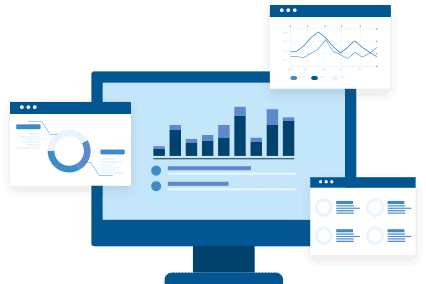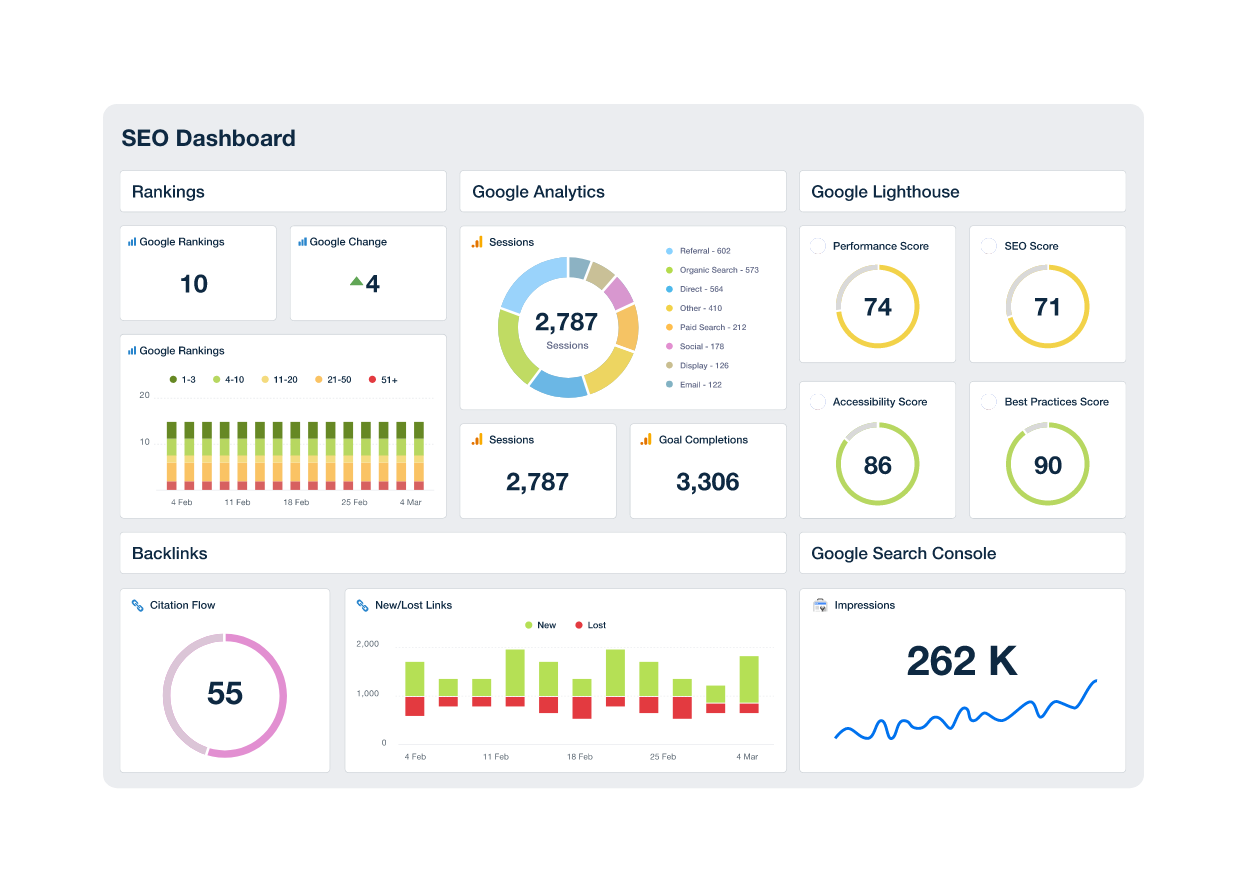
If you manage SEO campaigns for multiple clients, an SEO reporting dashboard is essential. It not only demonstrates SEO success, but also provides actionable insights, streamlines your reporting process, and builds client trust. With the right tools, metrics, and design, you can create a client-friendly dashboard that showcases the value of your SEO services.
This guide will explain how to build an SEO dashboard, what key metrics to include, tools you can use, and tips for automated SEO reporting that impresses clients.
What Is an SEO Reporting Dashboard?
An SEO reporting dashboard is a centralized interface that visualizes key metrics and performance data for a client’s website. It allows SEO specialists and clients to monitor website traffic, keyword rankings, backlink profiles, technical SEO issues, and conversion metrics in one place.
Why Dashboards Matter for SEO Agencies and Clients
- Build Client Trust: Transparent reporting shows tangible results from SEO campaigns.
- Save Time: Consolidates data from multiple SEO tools like Google Analytics, rank trackers, and SEO reporting tools.
- Enable Data-Driven Decisions: Helps SEO professionals prioritize campaigns based on performance insights.
- Demonstrate ROI: Shows the impact of your SEO efforts on leads, sales, and organic traffic.
Key Benefits of an SEO Reporting Dashboard
1. Improved Client Communication
Dashboards transform raw SEO analytics into easy-to-read visual reports. Clients understand the impact of your content marketing, digital marketing, and SEO efforts, increasing satisfaction and retention.
2. Real-Time Performance Tracking
Integrate live data from tools like Google Looker Studio, Google Analytics, SEMrush, and Ahrefs. Track website traffic, keyword ranking, and social media metrics in real time.
3. Actionable Insights for SEO Campaigns
Highlight underperforming areas like technical SEO issues, thin content, or low-converting landing pages, so your team can take immediate action.
4. Time Efficiency
Automated dashboards reduce manual reporting tasks, giving SEO professionals and specialists more time to focus on strategy, content optimization, and link building.
Essential Metrics to Include in Your SEO Dashboard
Organic Traffic Metrics
- Sessions, pageviews, and unique users
- Traffic sources: Google, social media, referrals, and paid ads
- Mobile vs desktop users
Keyword Rankings
- Ranking positions for target keywords
- Keyword trends over time using rank tracker tools
- Competitor keyword comparisons
On-Page SEO Metrics
- Meta tag optimization (titles, descriptions)
- Heading structure, internal linking, and content audits
- SEO performance of blog posts, landing pages, and content marketing campaigns
Backlink & Authority Metrics
- Total backlinks and referring domains
- Domain Authority (DA) / Page Authority (PA)
- Toxic link detection
Technical SEO Metrics
- Crawl errors, indexing issues, and broken links
- Website speed and Core Web Vitals (LCP, FID, CLS)
- Mobile responsiveness and HTTPS security
Conversion & ROI Metrics
- Leads, form submissions, and ecommerce sales
- Funnel analysis and goal completions
- SEO impact on revenue and digital marketing campaigns
Tools to Build Your SEO Reporting Dashboard
Free and Paid Reporting Tools
- Google Looker Studio (Data Studio): Free and customizable, integrates multiple SEO data sources.
- Google Analytics: Tracks website traffic, user behavior, and conversions.
- Google Search Console: Provides insights on indexing, crawl errors, and keyword performance.
- SEMrush and Ahrefs: Paid tools for backlink analysis, keyword ranking, and competitor tracking.
- Google Sheets: Can create simple, automated SEO reports and marketing dashboards.
- Rank Trackers: Monitor keyword performance over time for clients’ websites.
Why Use an SEO Reporting Tool
An SEO reporting tool centralizes all your campaign metrics, allowing SEO specialists to create client reports quickly, improving transparency and efficiency.
How to Build an SEO Dashboard Step-by-Step
Step 1: Define Your Goals
Identify the purpose of the dashboard: Client reporting, internal analysis, or both. Focus on metrics that demonstrate ROI and support your SEO strategy.
Step 2: Choose the Right Tools
Popular tools for building dashboards include:
- Google Data Studio / Looker Studio – Free and customizable with live data integration
- SEMrush My Reports – Client-friendly SEO reporting with templates
- Ahrefs – For backlink and keyword ranking insights
- Google Analytics – Organic traffic and user behavior
- Screaming Frog – Technical SEO audit data
Step 3: Select Key SEO Metrics
Only include metrics that are relevant to the client’s business goals. Too much data can overwhelm clients.
Step 4: Design for Clarity
- Use charts, graphs, and tables for visual storytelling
- Segment data into sections: traffic, rankings, technical, backlinks, and conversions
- Use color coding to highlight trends or issues
Step 5: Automate Reporting
- Connect dashboards to live data sources for real-time updates
- Schedule automated reports for weekly or monthly delivery
Step 6: Add Context and Insights
- Provide a brief summary highlighting performance trends
- Explain actionable next steps and recommendations
Tips for a Client-Friendly SEO Dashboard
- Keep it simple, visually appealing, and intuitive
- Focus on metrics that directly impact business outcomes
- Include historical comparisons to show progress
- Highlight success stories and improvements
- Integrate Google My Business SEO data for local SEO clients
FAQ: SEO Reporting Dashboards
Q1: Why should I use an SEO reporting dashboard?
An SEO dashboard consolidates all critical SEO metrics in one place, improves communication with clients, saves time, and demonstrates measurable results, helping justify SEO service pricing.
Q2: What tools are best for building SEO dashboards?
Free tools like Google Looker Studio and Google Sheets are excellent for custom dashboards. Paid tools like SEMrush, Ahrefs, Moz, and rank trackers offer pre-built templates for faster reporting.
Q3: Which SEO metrics should I include?
Include organic traffic, keyword rankings, backlinks, technical SEO issues, on-page optimization, conversions, and local SEO metrics like Google Business Profile visibility for local clients.
Q4: Can dashboards improve client retention?
Yes. Providing transparent, clear reporting shows tangible ROI from your SEO campaigns, building trust and increasing long-term client retention.
Q5: How often should SEO dashboards be updated?
Monthly updates are standard, but real-time dashboards can be used for internal tracking and SEO campaign optimization.
Q6: Can dashboards track social media and digital marketing impact?
Absolutely. Include social media marketing, content marketing, and marketing dashboard metrics to demonstrate multi-channel performance.
Conclusion
A well-crafted SEO reporting dashboard is a powerful tool for SEO agencies, specialists, and clients. It not only showcases SEO campaign success, website traffic growth, and content marketing results, but also provides actionable insights for future strategies.
By integrating automated SEO reports, SEO analytics dashboards, rank trackers, and Google My Business SEO data, your team can save time while impressing clients with clear, data-driven performance metrics.
Investing in a professional dashboard ensures client satisfaction, improved retention, and long-term SEO success — a win-win for both agencies and clients.



